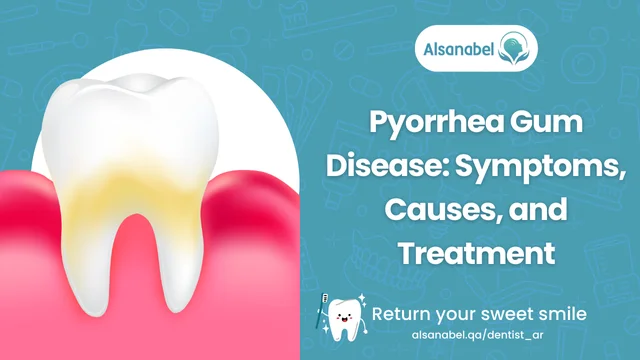
Gum health plays a vital role in maintaining overall oral hygiene, yet many individuals unknowingly suffer from advanced gum diseases such as pyorrhea gum disease. This condition, often referred to as periodontitis, is a severe form of gum disease that can lead to tooth loss if left untreated. Understanding what is pyorrhea, recognizing the symptoms of pyorrhea, and seeking effective treatment for pyorrhea can help preserve oral health and prevent serious complications.
What is Pyorrhea?
Many people ask, what is pyorrhea, and how does it differ from other gum diseases? Pyorrhea is a severe gum infection that occurs due to prolonged bacterial plaque buildup along the gum line. As the condition progresses, it leads to inflammation, gum recession, pus formation, and ultimately, damage to the bone supporting the teeth.

While early-stage gum disease, known as gingivitis, is reversible with proper oral care, pyorrhea gum disease is more advanced and requires professional dental intervention to prevent tooth loss.
What Are the Causes of Pyorrhea?
Understanding the causes of pyorrhea gum disease is crucial for prevention and treatment. Several factors contribute to the development of this condition, including:
1. Poor Oral Hygiene
Neglecting daily brushing and flossing allows plaque and bacteria to accumulate along the gum line, leading to infections and inflammation.
2. Uncontrolled Bacterial Growth
The mouth naturally contains bacteria, but poor oral hygiene can lead to excessive bacterial growth, which triggers gum disease.
3. Genetic Predisposition
Some individuals are genetically more prone to pyorrhea disease, making it essential to follow preventive measures diligently.
4. Smoking and Tobacco Use
Tobacco products weaken the immune system, making it harder for the body to fight off gum infections. Smokers are significantly more likely to develop pyorrhea gum disease than non-smokers.
5. Nutritional Deficiencies
Lack of essential nutrients such as vitamin C and calcium can weaken gum tissues, making them more susceptible to infections.
6. Underlying Health Conditions
Diabetes, heart disease, and immune system disorders can increase the risk of pyorrhea disease due to the body’s reduced ability to fight infections.
7. Stress and Poor Lifestyle Choices
Chronic stress weakens the immune system, while poor dietary habits contribute to bacterial overgrowth and plaque accumulation.
What Are the Symptoms of Pyorrhea?
Recognizing the symptoms of pyorrhea early is essential for seeking timely treatment and preventing complications. Some of the most common signs include:
1. Bleeding Gums
One of the earliest and most noticeable symptoms of pyorrhea is gum bleeding, especially while brushing or flossing.
2. Persistent Bad Breath (Halitosis)
Chronic bad breath, even after brushing, can indicate bacterial infection and pus formation in the gums.
3. Swollen, Red, or Tender Gums
Inflammation and redness in the gums often signal gum disease progression.
4. Gum Recession
As pyorrhea gum disease advances, the gums begin to pull away from the teeth, creating deep pockets that trap bacteria and debris.
5. Pus Formation and Gum Abscesses
Severe infections can lead to pus-filled pockets along the gum line, causing pain and discomfort.
6. Loose or Shifting Teeth
As the disease progresses, the supporting bone structure weakens, causing teeth to become loose or shift in position.
7. Pain While Chewing
Pain or discomfort while eating, especially when biting, may indicate infection or bone loss caused by pyorrhea gum disease.
Identifying these symptoms of pyorrhea early is critical for effective treatment and preventing tooth loss.
How is Pyorrhea Treated?
Once diagnosed, seeking the right treatment for pyorrhea is essential for halting disease progression and restoring gum health. Depending on the severity, treatment options range from non-invasive methods to advanced surgical procedures.
1. Professional Dental Cleaning (Scaling and Root Planing)
For mild to moderate cases, deep cleaning procedures such as scaling and root planing help remove plaque and tartar from below the gum line.
- Scaling: Removes hardened plaque (tartar) and bacteria from the tooth surface.
- Root Planing: Smooths the root surfaces to prevent bacteria from accumulating again.
This procedure is one of the most effective non-surgical treatment for pyorrhea and significantly reduces inflammation.
2. Antibiotic Therapy
In some cases, dentists prescribe antibiotics to combat bacterial infection and promote healing. These may be taken orally or applied directly to the affected gum pockets.
3. Laser Therapy
Advancements in dental technology have introduced laser treatment, which effectively removes infected gum tissue and bacteria while promoting faster healing.
4. Surgical Treatments for Advanced Pyorrhea
If pyorrhea disease is in an advanced stage, surgical intervention may be required to restore gum and bone health.
- Flap Surgery (Pocket Reduction Surgery): Removes infected tissue and reattaches healthy gum tissue to the teeth.
- Bone Grafting: Used in cases where bone loss has occurred, restoring support for teeth.
- Gum Grafting: Helps cover exposed roots and prevents further recession.
5. Home Remedies and Lifestyle Changes
In addition to professional treatments, maintaining good oral hygiene at home is vital for preventing the recurrence of pyorrhea gum disease.
- Brush twice daily with fluoride toothpaste.
- Floss daily to remove plaque from between teeth.
- Use an antibacterial mouthwash to kill harmful bacteria.
- Avoid smoking and tobacco use.
- Follow a nutrient-rich diet to support gum health.
These combined efforts ensure the effectiveness of treatment for pyorrhea and help maintain long-term oral health.
Can Pyorrhea Lead to Tooth Loss?
Yes, untreated pyorrhea gum disease can eventually lead to tooth loss. As the infection progresses, it weakens the bone structure that supports the teeth. Once the bone deteriorates significantly, teeth may become loose and eventually fall out or require extraction.
To prevent this, it is crucial to seek timely treatment for pyorrhea and follow a strict oral hygiene routine.
Frequently Asked Questions About Pyorrhea Gum Disease

1. What is pyorrhea gum disease?
Pyorrhea, also known as periodontitis, is a severe gum infection that damages the soft tissue and bone supporting the teeth, potentially leading to tooth loss if untreated.
2. What are the causes of pyorrhea?
The primary causes of pyorrhea gum disease include poor oral hygiene, bacterial plaque buildup, smoking, genetic predisposition, nutritional deficiencies, and underlying health conditions.
3. How is pyorrhea treated?
Treatment for pyorrhea includes professional dental cleanings, scaling and root planing, antibiotic therapy, laser treatment, and, in severe cases, surgical procedures like gum grafting or bone grafting.
4. Can pyorrhea lead to tooth loss?
Yes, if left untreated, pyorrhea gum disease can cause bone deterioration, leading to loose teeth and eventual tooth loss.
5. What are the symptoms of pyorrhea?
Common symptoms of pyorrhea include bleeding gums, persistent bad breath, gum recession, pus formation, loose teeth, and pain while chewing.
Understanding what is pyorrhea, recognizing its symptoms of pyorrhea, and seeking timely treatment for pyorrhea can prevent severe complications and ensure long-term oral health. Since pyorrhea disease is a progressive condition, early intervention and proper oral hygiene are crucial for keeping gums healthy and preventing tooth loss. If you suspect gum disease, consult a dentist immediately to explore the best treatment options available.
%20(2).jpg)
